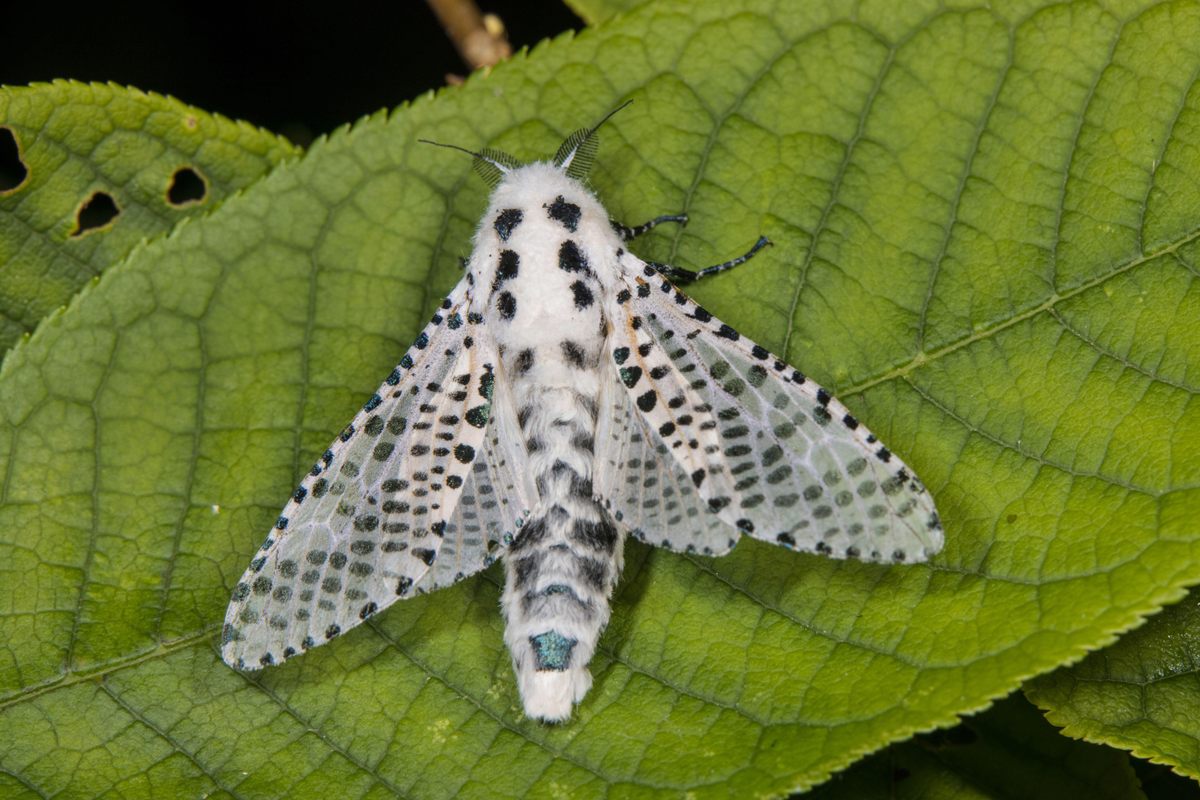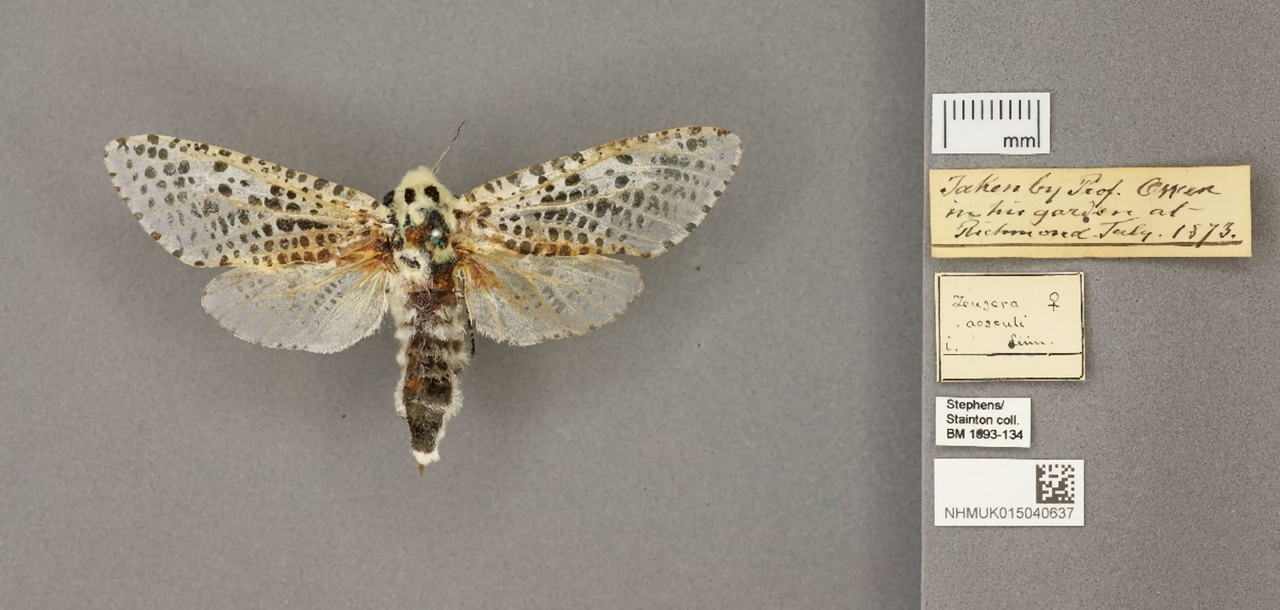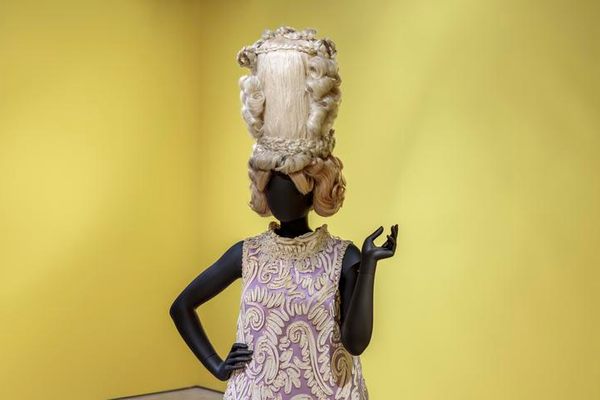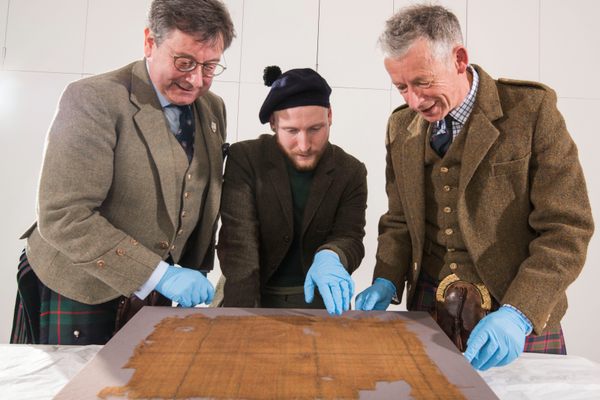What Can a Long-Forgotten Moth Tell Us About Climate Change?
The 149-year-old specimen is one of millions at Britain’s Natural History Museum.
There aren’t a lot of surprises in the work of digitizing the more than 10 million moths and butterflies at the Natural History Museum in London, England. The process is quite routine: you pick a drawer filled with 100 to 200 moths, remove one specimen very carefully with pliers, place it on a tray, take a picture of it and its label, and then return it to the same exact spot. Then you do it all again.
But for digitizer Louise Berridge, this meticulous process led to a rather unusual discovery. Toward the end of one of her workdays in July 2022, Berridge was making her way through a drawer of leopard moths, precisely aligned one after another. Because these moths can grow to have wingspans of about 10 inches—larger than an average human handspan—they have to be carefully maneuvered in order to read their labels. One particular moth, with its sand-colored wings polka-dotted in black blotches, was obscuring most of its label, but Berridge could see that the part of the description read, “taken by Prof. Owen.” She casually wondered if it was the Professor Owen; as in Richard Owen, founder of the museum she was working in.

Owen, a 19th-century biologist and paleontologist, wasn’t known to have worked with insects so this find felt too good to be true. But the label said that the moth was collected in Richmond, a town outside of London, and a quick Google search confirmed that Owen had lived there. Berridge decided to dig further. The leopard moth was actually part of a collection by entomologist and butterfly expert Henry Stainton, Berridge and her colleagues checked the archives for any documentary evidence that he and Owen knew each other.
Though they did not find any, the researchers concluded that because the moth was in Stainton’s collection, it was likely that the two prominent English scientists knew each other and that Owen gave the moth to Stainton. “We think that probably because Owen knew that Stainton was a moth or butterfly expert, he thought that Stainton would like this and just picked it up from his garden,” Berridge explains.
Richard Owen is more widely recognized for his work and contributions to the study of fossils, particularly dinosaurs. So it’s unusual that a specimen such as the leopard moth could be part of Owen’s body of work. “We know that Owen described the rhino bot fly very early in his career,” Berridge says, but that such flies only live inside rhinos. Unfortunately, these specimens, once housed in the Hunterian Museum were destroyed by the Blitz.

“Our moth is currently the only insect that we know of that Owen collected that is still in existence,” says Berridge. It’s also one of the oldest leopard moths in the museum’s collection.
When it announced the rediscovery of Owen’s moth, the Natural History Museum held the specimen up as evidence of the importance of digitization projects; to date the museum has digitized just over 6 percent of its 80 million. specimens. But this moth and its long-dead companions have also been used by researchers around the world to study the impacts of climate change.
Moths and butterflies are part of the Lepidoptera order of insects and are known to be very sensitive to changes in land use and temperature. “Moths are very good environmental indicators,” explains Berridge. “Because the times that they emerge and when they lay their eggs are so dependent on temperature, through our historical collection we can see when they were found in the past and see if it is different now.”
According to entomologist Akito Y. Kawahara, who is also a professor and curator at the Florida Museum of Natural History at the University of Florida, moths and butterflies play significant roles in our ecosystem. “They are incredibly good model organisms because they’re so diverse,” said Kawahara. There may be well over one million species of moths and butterflies and their roles as pollinators and food sources—as well as the fact that they are easily identifiable—makes them great resources for understanding our changing natural environment.

People have been collecting moths and butterflies for centuries, Kawahara said, and because of that, there is always readily available information about them. “You can basically pinpoint the insect to a particular point in time,” he said, “and then you can look at what the climate was like at that time.”
Leopard moths can still be found in the gardens of Richmond today. The question for climate change scientists is, where will they be tomorrow? According to one study, only about 17 percent of the world’s land is currently climatically appropriate for these moths, with 74 percent of that being in Europe. But as temperature and weather patterns continue to change, these pests could one day make their home in Northern Africa, North America, parts of Latin America, and parts of Oceania.






























Follow us on Twitter to get the latest on the world's hidden wonders.
Like us on Facebook to get the latest on the world's hidden wonders.
Follow us on Twitter Like us on Facebook